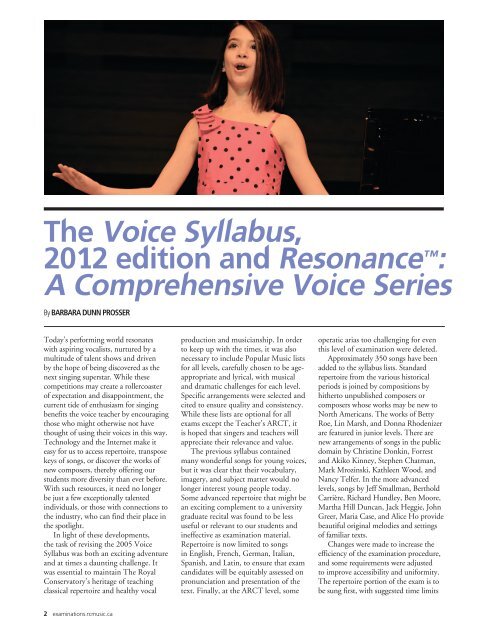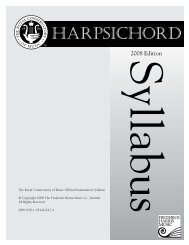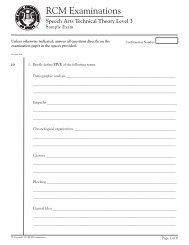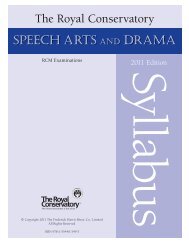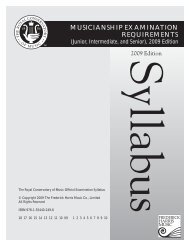Spring 2012 - RCM Examinations
Spring 2012 - RCM Examinations
Spring 2012 - RCM Examinations
You also want an ePaper? Increase the reach of your titles
YUMPU automatically turns print PDFs into web optimized ePapers that Google loves.
The Voice Syllabus,<br />
<strong>2012</strong> edition and Resonance :<br />
A Comprehensive Voice Series<br />
By BARBARA DUNN PROSSER<br />
Today’s performing world resonates<br />
with aspiring vocalists, nurtured by a<br />
multitude of talent shows and driven<br />
by the hope of being discovered as the<br />
next singing superstar. While these<br />
competitions may create a rollercoaster<br />
of expectation and disappointment, the<br />
current tide of enthusiasm for singing<br />
benefits the voice teacher by encouraging<br />
those who might otherwise not have<br />
thought of using their voices in this way.<br />
Technology and the Internet make it<br />
easy for us to access repertoire, transpose<br />
keys of songs, or discover the works of<br />
new composers, thereby offering our<br />
students more diversity than ever before.<br />
With such resources, it need no longer<br />
be just a few exceptionally talented<br />
individuals, or those with connections to<br />
the industry, who can find their place in<br />
the spotlight.<br />
In light of these developments,<br />
the task of revising the 2005 Voice<br />
Syllabus was both an exciting adventure<br />
and at times a daunting challenge. It<br />
was essential to maintain The Royal<br />
Conservatory’s heritage of teaching<br />
classical repertoire and healthy vocal<br />
2 examinations.rcmusic.ca<br />
production and musicianship. In order<br />
to keep up with the times, it was also<br />
necessary to include Popular Music lists<br />
for all levels, carefully chosen to be ageappropriate<br />
and lyrical, with musical<br />
and dramatic challenges for each level.<br />
Specific arrangements were selected and<br />
cited to ensure quality and consistency.<br />
While these lists are optional for all<br />
exams except the Teacher’s ARCT, it<br />
is hoped that singers and teachers will<br />
appreciate their relevance and value.<br />
The previous syllabus contained<br />
many wonderful songs for young voices,<br />
but it was clear that their vocabulary,<br />
imagery, and subject matter would no<br />
longer interest young people today.<br />
Some advanced repertoire that might be<br />
an exciting complement to a university<br />
graduate recital was found to be less<br />
useful or relevant to our students and<br />
ineffective as examination material.<br />
Repertoire is now limited to songs<br />
in English, French, German, Italian,<br />
Spanish, and Latin, to ensure that exam<br />
candidates will be equitably assessed on<br />
pronunciation and presentation of the<br />
text. Finally, at the ARCT level, some<br />
operatic arias too challenging for even<br />
this level of examination were deleted.<br />
Approximately 350 songs have been<br />
added to the syllabus lists. Standard<br />
repertoire from the various historical<br />
periods is joined by compositions by<br />
hitherto unpublished composers or<br />
composers whose works may be new to<br />
North Americans. The works of Betty<br />
Roe, Lin Marsh, and Donna Rhodenizer<br />
are featured in junior levels. There are<br />
new arrangements of songs in the public<br />
domain by Christine Donkin, Forrest<br />
and Akiko Kinney, Stephen Chatman,<br />
Mark Mrozinski, Kathleen Wood, and<br />
Nancy Telfer. In the more advanced<br />
levels, songs by Jeff Smallman, Berthold<br />
Carrière, Richard Hundley, Ben Moore,<br />
Martha Hill Duncan, Jack Heggie, John<br />
Greer, Maria Case, and Alice Ho provide<br />
beautiful original melodies and settings<br />
of familiar texts.<br />
Changes were made to increase the<br />
efficiency of the examination procedure,<br />
and some requirements were adjusted<br />
to improve accessibility and uniformity.<br />
The repertoire portion of the exam is to<br />
be sung first, with suggested time limits


